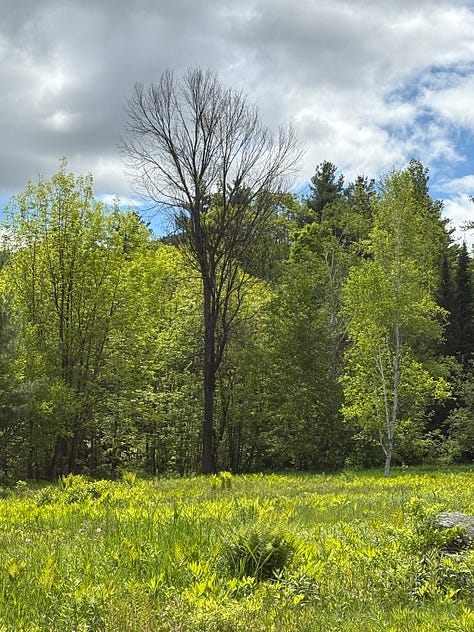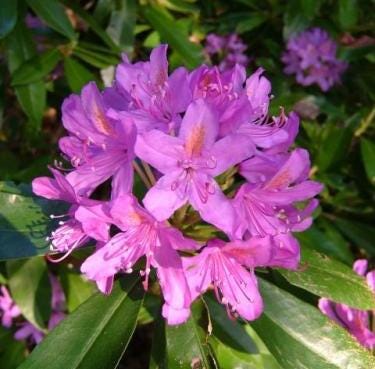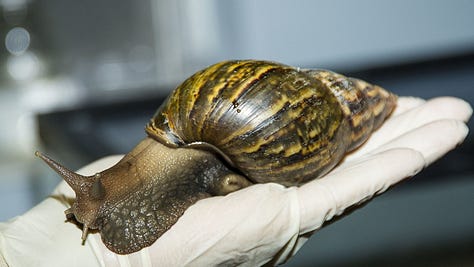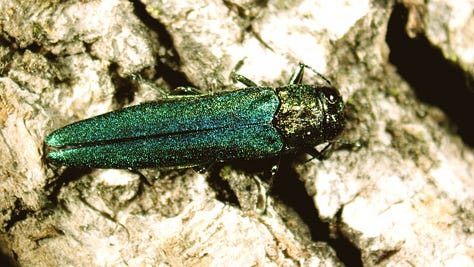The elm tree is dead. A grim silhouette in May’s frolic of young green leaves, our grand old elm stands black and bare. The Dutch elm disease, Ophiostoma ulmi, has finally choked the tree to death, stuffing its xylem cells with fungi.1
The fungi is an invasive pathogen that came in the 1930s to America from Europe, perhaps in a shipment of beautiful golden yellow elm wood. It has killed one of our most elegant trees, a high reaching vase-shaped tree with foliage that cascades from the crown of the tree almost down to the ground.
There were once rows of elms along Main Street in every American town. Rudy remembers when elms marched across Meadow Brook alongside Route 25. Now one of the last elms in our town is gone.
At first, when explorers and colonists came to the Americas, no one had any idea about invasives. Hernando de Soto brought pigs to Florida in 1539 as a portable larder for his 600 men. The pigs were perhaps the western hemisphere’s first invasive, carrying disease and disrupting whole ecosystems as they ran wild along de Soto’s route.
Fishermen, fur trappers and surveyors brought measles, smallpox, yellow fever and many other European diseases to North America’s indigenous people long before Virginia Dare was born in the first colony. Native Americans had no immunity to these foreign pathogens.2 Historians estimate anywhere from 20 million to 50 million to 90 million Native Americans were killed by invisible enemies that came on the explorers’ breath, their clothes and skin. Europeans were the invasive.
As the age of exploration exploded, many ships carried botanists and biologists with them to explore the new and curious plants and animals the Europeans encountered. Great Britain’s captains were famous for their finds. Humboldt, Joseph Banks, Charles Darwin are names we know as great naturalists who enriched our knowledge of plants and animals.
As early as 1650, John Tradescant brought beautiful rhododendrons from the Orient to England’s renowned gardens. Thomas Jefferson imported 300 varieties of peas to his gardens at Monticello. Gardeners, farmers, industrialists wanted to bring back and propagate the best spices, the best tea, silk worms, potatoes, a wealth of new opportunities.






Who knew that the rhodies could take over a forest?
Today we have quite a different opinion of beautiful, delicious, weird and wonderful foreign plants and animals. The U.S. Department of Agriculture has built a wall around us with its Animal and Plant Health Inspection Service (APHIS).
APHIS guards our borders against unwanted intruders, everything from fungi and pathogens and the beetles that spread them to giant land snails, a disease that could kill Maine’s entire potato crop, another that could wipe out our dairy herds. APHIS biologists and botanists inspect flowers that come across our borders, quarantine sheep and horses, sift through imported coffee and tea. They inspect pallets that carry Chinese electronics and search for hitchhiking insects and microbes in airplane wheel hubs and cargo ship hawseholes.
I met an APHIS detective years ago when I taught English classes for the USDA. The young biologist told my class he worked for APHIS. When I asked him to explain, he told us about visiting fields of lettuce in Florida where giant snails had suddenly appeared. The mollusks were marching across acres of cropland, munching away on everything in their path. My student tracked the snails backwards until he came to a small house on the edge of the fields.
“Oh, yes,” said the grandmotherly resident. “My grandson visited his other grandmother in Africa. When he came home, I found one of those ugly things, a little one, in his pants pocket. I threw it out the window.”
APHIS inspectors, over the 53 years their agency has been working, have developed an amazing partnership with citizens, farmers, foresters, and university professors and their graduate students.
Anyone who has flown home from a trip abroad has heard the stewardess ask us to empty our pockets of the fruits and nuts we brought on board for snacks. Farmers are eager to call APHIS if they cut open an imported seed potato and find some ugly rot. I called veterinarian Julie Dolan long ago when one of my Hampshire sheep had a strange twitch.
Dr. Julie came right over. She climbed into the pen and grabbed my big ewe, her hands spread out along the animal’s spine. The sheep grimaced and twisted in pain.
Julie said, “I’ll be back.” She returned with a tiny clipping from a veterinary magazine. “I’m sorry, Monty. I had to report this.”
A few days later, a black sedan arrived at my barn. A veterinarian from Tufts University stepped into the barn. He gave my ewe the same test. Again, she rolled back her lips and grimaced. “I’m taking this animal,” he announced.
The man walked the big ewe out of her pen to his black sedan. He opened the trunk. He gave my ewe an injection and tipped her over into the trunk. He slammed the trunk closed the trunk.
“But wait…!” I cried.
Then the vet asked me to show him my records for every sheep, its identification number and where I had bought it. He expected numbers for each ewe’s ear tags. My 4-H flock had names, Sunshine, Petunia, Iris. He wrote the names down. All the ewes were born in our barn.
Only the rams came from other farms. I had to recall each one, Alfred from a farm in Somersworth, Bennie from a farm in New Hampton, Charlie from…”
Tufts labs found that my ewe was infected with scrapie, transmissible spongiform encephalopathy, a prion, a free protein that can kill a sheep. Scrapie is a cousin to prions that are called Mad Cow disease in cattle, Creutzfeldt Jakob’s disease in humans.
The Tufts vet returned a few weeks later and killed all of our sheep. We never raised sheep again. And Tufts tracked the disease to one of the farms where we had bought a beautiful healthy looking ram. All the sheep on that farm were killed too.
APHIS has been doing the same grim work to protect Americans most recently with poultry, working to contain bird flu, another invasive. At least until recently.
In late February, the New York Times reported that Trump has fired 145 scientists and field workers in APHIS as well as hundreds of young probationary new employees.
I read about Dr. Jonah Ulmer, “current curator of Thysanoptera and Psylloidea for the Smithsonian National Museum of Natural History in Washington DC.”3 Dr. Ulmer is the only person between us and thrips and psyllids, tiny little insects that can wipe out an entire crop of fruit, like oranges or strawberries.
I couldn’t find out whether Dr. Ulmer and his colleagues have been rehired or allowed to return to work at least temporarily. But on LinkedIn, I discovered that federal employees are writing to one another and posting their thoughts.
One former colleague of Ulmer’s, retired a few years ago after 45 years with USDA, Dr. Kevin Shea wrote “Because of you, food is abundant. Because of you, research has put tools in the hands of farmers and ranchers. Because of you, poor people need not go hungry. Because of you, many rural Americans own homes and their communities have infrastructure. Because of you, there are forests to visit and provide economic value.”
Now if some new fungi, beetle or plant arrives on our shores and threatens my sugar maples or red oaks, no one will know until it’s too late.
Our forest has already lost much of its diversity from invasives. The chestnut were the first to go, killed by another fungus, Cryphonectria parasitica. These magnificent trees dominated the great Appalachian forest, a forest that rivaled the Amazon in size and diversity.
More recently, we have lost the ash tree to the emerald ash borer. In the Midwest, ash was a primary tree. Here it is a lesser member of our forest but the dead branches are a grim standout along the roads in Center Sandwich.
Other forest predators are still a bit south of us, moving north as our climate warms. The Asian long-horned beetle killed almost every maple tree in Worcester, Massachusetts. The maples there, planted a century ago, lined the streets of the old industrial city, cooling hot pavement, beautifying cold granite. All of the maples were cut down, Worcester, bleak and barren.
The wooly adelgid is a tiny insect that kills hemlock trees. When his students found the adelgid in College Woods, a beautiful stand of old old hemlocks, forest ecology professor Dr. Thomas Lee reportedly burst into tears. I hope the adelgids don’t come to the secret stand of old growth hemlocks on Bearcamp Pond.
Beech trees are under siege from a beech scale insect, another invasive. When this bug feeds on the bark of the beech, it opens cracks in the smooth grey skin of the tree, allowing a fungal canker to slip in. The cankers the fungus causes soon kill the tree. Bears no longer climb our beech trees to harvest beech nuts. The trees die before they are old enough to make nuts.
The diversity of our forest gives it resilience, food and habitat for different animals, a wealth of different woods, an ecosystem of trees that hosts a myriad of insects, birds, reptiles, fungi, and other forest citizens. Foresters wonder how many more species can we lose before the ecosystem collapses.4
I wonder what we should do about the grim leafless elm and how much it will hurt Rudy when I tell him his beloved elm is dead.
Edmonds, Robert L., James K. Agee, and Robert I. Gara, 2000, Forest Health and Protection, Waveland Press; Elms and Dutch Elm Disease: A Quick Overview, https://www.fs.usda.gov/nrs/pubs/gtr/gtr-nrs-p-174papers/01marcotrigiano-gtr-p-174.pdf
Ehrenpreis, Jamie E. and Eli D. Ehrenpreis, A Historical Perspective on Healthcare Disparity and Infectious Disease in the Native American Population, https://pmc.ncbi.nlm.nih.gov/articles/PMC8785365/
https://www.nbcnews.com/news/us-news/usda-fired-expert-invasive-pests-can-decimate-crops-rcna194913
Bormann F.H. 1985. Air Pollution and forests: An ecosystem perspective. BioScience 35:7, pp. 434-441.




I am so saddened by your essay. I am crying. Our wonderful dedicated scientists and detectives are to be given heart-felt praises. May we travel through this chaotic time as quickly as possible.
Everyone in Sandwich NH should read this.